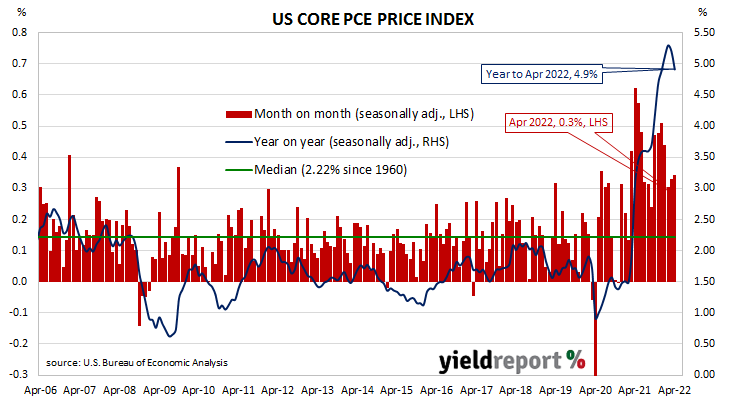Summary: US core PCE price index up 0.3% in April; in line with expectations; annual rate slows from 5.2% to 4.9%; due to downward move in durable goods prices; Treasury yields down modestly; 210bps of Fed rate rises priced in over next 12 months.
One of the US Fed’s favoured measures of inflation is the change in the core personal consumption expenditures (PCE) price index. After hitting the Fed’s target at the time of 2.0% in mid-2018, the annual rate then hovered in a range between 1.8% and 2.0% before it eased back to a range between 1.5% and 1.8% through 2019. It then plummeted below 1.0% in April 2020 before rising back to around 1.5% in the September quarter of that year. It has since ran up well above the Fed’s target.
The latest figures have now been published by the Bureau of Economic Analysis as part of the April personal income and expenditures report. Core PCE prices rose by 0.3% over the month, in line with expectations as well as March’s increase. On a 12-month basis, the core PCE inflation rate slowed from March’s figure of 5.2% to 4.9%.
“The drop in core PCE was due to a downward move in durable goods prices, which eased to 8.4% versus 10.2%,” said ANZ Head of Australian Economics David Plank. He pointed to a “normalisation” in vehicle production which is “taking the heat out of second-hand car prices.”
US Treasury bond yields fell modestly on the day. By the close of business, the 2-year Treasury bond yield had lost 2bps to 2.46% while 10-year and 30-year yields both finished 1bp lower at 2.74% and 2.97% respectively.
In terms of US Fed policy, expectations of a higher federal funds rate over the next 12 months softened slightly. At the close of business, June contracts implied an effective federal funds rate of 1.085%, 25bps higher than the current spot rate. July contracts implied a rate of 1.40% while May 2023 futures contracts implied 2.93%, 210bps above the spot rate.
The core version of PCE strips out energy and food components, which are volatile from month to month, in an attempt to identify the prevailing trend. It is not the only measure of inflation used by the Fed; the Fed also tracks the Consumer Price Index (CPI) and the Producer Price Index (PPI) from the Department of Labor. However, it is the one measure which is most often referred to in FOMC minutes.


